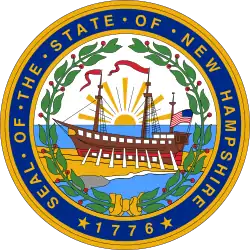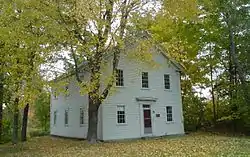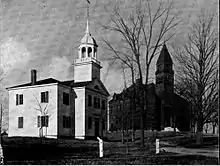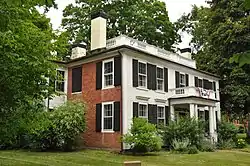List of New Hampshire historical markers (251–275)
This page is one of a series of pages that list New Hampshire historical markers. The text of each marker is provided within its entry. Although there are less than 275 markers, the name of this page allows for future expansion. A notice on the website of the New Hampshire Division of Historical Resources, dated October 14, 2020, advises that state-funded markers are "currently on hold due to the current budget constraints related to COVID-19".[1]
| No. | Title | Location |
|---|---|---|
| 251 | Dr. Jennie Sarah Barney (1861–1956) | Grafton |
| 252 | Bungtown | Grafton |
| 253 | Londonderry Turnpike | Salem |
| 254 | 'The Avenues' Neighborhood | Berlin |
| 255 | The City That Trees Built | Berlin |
| 256 | Gerrish Depot | Boscawen |
| 257 | Frances Glessner Lee (1878–1962) 'Mother of Forensic Science' | Bethlehem |
| 258 | Webster Stagecoach Stop and Store | Danville |
| 259 | Nottingham Square | Nottingham |
| 260 | Captain Peter Powers Homestead Site | Hollis |
| 261 | BASIC: The First User-Friendly Computer Programming Language | Hanover |
| 262 | Charles E. Tilton's Legacy | Tilton |
| 263 | Franconia College 1963–1978 | Franconia |
| 264 | Home Of John Parker Hale, 1840–1873 | Dover |
| 265 | Cornish Meetinghouse | Cornish |
| 266 | Pinkerton Academy / Old Academy Building | Derry |
| 267 | Abbot-Spalding House | Nashua |
| Notes • References • External links | ||
| List of New Hampshire historical markers (251–275) | |
|---|---|
 | |
Markers 251 to 275
251. Dr. Jennie Sarah Barney (1861–1956)
- Town of Grafton
Location: Intersection of U.S. Route 4 and Prescott Hill Road[2]
"Born to a prominent family in Grafton, J. Sarah Barney graduated valedictorian from Boston University with degrees in medicine and surgery in 1896. A founding doctor at Franklin Hospital, where she practiced from 1910 to her retirement, Dr. Barney was remembered for her grit, humor, and involvement with women's suffrage. Upon her death, newspapers called her a pioneer and urged young readers to 'gather a little inspiration from the life of Dr. Barney to face up to the problem of the hour.' "[3]
252. Bungtown
- Town of Grafton
Location: Turnpike Road off of U.S. Route 4[2]
"In the 19th century this industrial village developed between the Grafton Turnpike and the banks of Mill Brook. East Grafton was once known as Bungtown, a name derived from an accident involving an overturned cart of failed barrel stoppers or 'bungs.' At peak production, one could find shingles, clapboards, cider, harnesses, axes, paint, woolens, bobbins, carriages, and coffins made here, powered by several mill ponds. Today, the carding mill, axe factory, and harness shop still stand."[3]
253. Londonderry Turnpike
- Town of Salem
Location: Old Rockingham Road[lower-alpha 1]
"Incorporated in 1804, this major highway completed the link between Concord, NH and Boston, MA, improving transportation of goods and personal travel. Granite posts marked many turnpikes, and this one in Salem marked the halfway point between Concord and Boston. The mileposts aided travelers and road maintenance crews. The marker was cemented into the stone wall in the 1940s after road repair. In 1956 the land was donated to the town to preserve memory of the original main route through Salem, NH on Old Rockingham Rd."[5]
254. 'The Avenues' Neighborhood
- City of Berlin
Location: Intersection of NH 110 and Hinchey Street[2]
" 'The Avenues,' a large neighborhood with small lots, was named for its north-south avenues, 1st to 6th. Housing construction was fueled by the booming paper industry and the arrival of the Berlin Street Railway in 1902. Over the next 30 years, many working-class immigrant families built single and multi-family houses in this ethnically-diverse neighborhood, which included many French-Canadian families, as well as those from Russia, Poland, Ireland, and Italy."[4]:21
255. The City That Trees Built
- City of Berlin
Location: Intersection of NH 110 and Green Street[2]
"Berlin became known as 'The City that Trees Built' after innovations in the 1870s replaced rags with wood pulp in paper manufacturing. As the paper industry expanded Berlin's population grew from 8,886 in 1900 to 20,018 in 1930. The Brown Company research laboratory, associated with a prominent mill company, held some 500 patents. While pulp, newsprint, and kraft shipping paper were major products, Brown Company manufactured many other wood-based items including chloroform, Kream Krisp shortening, Nibroc paper towels, and Bermico sewer pipes."[5]
256. Gerrish Depot
- Town of Boscawen
Location: U.S. Route 3 at Gerrish Depot[2]
"Constructed in 1855 to replace the original station, this is the oldest surviving depot on the former Northern Railroad. First known as 'North Boscawen Depot,' it was renamed in 1909 following a fatal train collision caused by confusion over similar station names, along with several other depots on the line. The name 'Gerrish' was chosen in honor of a prominent farming family. The depot provided freight and passenger service for local farms and residents, the state nursery, the county nursing home, and county jail until 1955."[6][7]
257. Frances Glessner Lee (1878–1962) 'Mother of Forensic Science'

- Town of Bethlehem
Location: U.S. Route 302 at Glessner Road[2]
"Here at the Rocks, her family’s summer estate, this Chicago heiress pursued her passion for criminology in the 1940s-50s with the creation of 20 miniature dioramas depicting actual crime scenes with detailed accuracy. Called the Nutshell Studies of Unexplained Death, the dioramas were based on crime scene statements and photographs, and were used to train homicide detectives. In recognition of her many contributions to forensic science, Glessner Lee was appointed an honorary Captain of the New Hampshire State Police in 1943."[8][9]
258. Webster Stagecoach Stop and Store
- Town of Danville
Location: NH 111A and Sandown Road[2]
"This small building, built ca. 1820, served as a stopover for a stagecoach route that passed through Danville. Passengers could buy refreshments while the horses rested and carriages were repaired. Early customer accounts remain intact, written on interior walls. Nathaniel Webster, third cousin to Daniel Webster and the town's first U.S. postmaster, ran the post office from this building. The stagecoach stop's history illustrates the importance of 19th century stagecoach culture, not only for travel but also for commerce and mail delivery."[10][11]
259. Nottingham Square

- Town of Nottingham
Location: Nottingham Square on NH 156[2]
"The Town of Nottingham was created by a Royal Charter in 1722. A plan of the town was completed in 1724; at that time the design of the Nottingham Square was laid out with the house lots and the intersecting streets of Bow, Fish, King and North. The town's first school, blockhouse and later meetinghouse were built on this summit. The site of militia drills in 1775 and home to four Revolutionary War generals, Nottingham Square served as the center of the town's business and social life for more than a century and remains common land for all."[12][13]
260. Captain Peter Powers Homestead Site
- Town of Hollis
"Hollis's first settlers of English descent, Capt. Peter Powers and his wife, Anna Keyes, established their homestead on this hill in 1730. An explorer, land surveyor and town officer, Capt. Powers also led the Hollis Company in the 1755 expedition to Crown Point, New York, during the French and Indian War. He and three sons served in the French and Indian War; four sons were soldiers in the Revolutionary War as well. Capt. Powers died of fever in 1757 at age 49, while Anna remained in Hollis until her death in 1798."[14][15]
261. BASIC: The First User-Friendly Computer Programming Language
- Town of Hanover
"In 1964, Dartmouth College math professors John Kemeny and Thomas Kurtz created one of the first user-friendly programming languages, called Beginners All-purpose Symbolic Instruction Code. BASIC made computer programming accessible to college students and, with the later popularity of personal computers, to users everywhere. It became the standard way that people all over the world learned to program computers, and variants of BASIC are still in use today."[16][17]
262. Charles E. Tilton's Legacy
- Town of Tilton
Location: Near Riverfront Park at U.S. Route 3[lower-alpha 2]
"Native Charles E. Tilton shaped his hometown through many gifts of monuments, buildings and parks—places that make the community special today. After moving to the West Coast in 1850, Tilton acquired extraordinary wealth through his trading company and investments. The citizens of Sanbornton Bridge voted to name their new town 'Tilton' in his family's honor after NH Governor Onslow Stearns approved the town's division from Sanbornton June 30, 1869."[18]
263. Franconia College 1963–1978
- Town of Franconia
"In 1963, an emerging Franconia College purchased the former Forest Hills grand hotel, built on this site in 1882. Bending the norms of higher education, the college offered selfdirected study, and administrative decisions were made by faculty and students at freewheeling community meetings. The experimental school was part of a national trend in progressive education during an era of revolution and change. Faced with mounting financial pressures, it closed its doors in 1978. By 1986 the building was no longer extant."[19]
264. Home Of John Parker Hale, 1840–1873
.jpg.webp)
- City of Dover
Location: NH 108 (Central Avenue)[2]
"New Hampshire lawyer, politician and noted abolitionist, Hale lived in this home for nearly 40 years, until his death. During this time, he was elected to the U.S. Congress as a Democrat in 1842, to the U.S. Senate as an Independent in 1847 and again to the U.S. Senate as a Republican in 1855. The first distinctly anti-slavery U.S. senator, he was friendly with President Lincoln, who named him Minister to Spain in 1865. A statue of Hale joins those of Daniel Webster and Gen. John Stark at the State House in Concord."[20]
265. Cornish Meetinghouse
- Town of Cornish
Location: Meetinghouse Road @ Cornish Stage Road[2]
"Built in 1803 as the First Baptist Church in the geographic center of town, the Cornish Meetinghouse was moved to the more populated mill and mercantile village of Cornish Flat in 1818. After its move, the belfry was added. Charlestown clockmaker Stephen Hasham's hand wound clock, installed in 1845, still keeps time and strikes the bell that was replaced in 1872. In 1883 the belfry was enclosed and a patterned slate roof was added. The building's exterior reflects architectural details from the Federal, Greek Revival and Queen Anne periods."[14]
266. Pinkerton Academy / Old Academy Building

- Town of Derry
Location: NH 28 Bypass (North Main Street)[2]
"Incorporated in 1814, Pinkerton Academy is the state's largest independent high school and is one of the oldest. Since its founding 'for the purpose of promoting piety and virtue and for the Education of Youth,' notable faculty and alumni include: poet and Pinkerton teacher Robert Frost (1906-11); Alan Shepard (1940), the first American in space; Brian Thacker (1963), who earned the Medal of Honor for his action in the Vietnam War; and Tricia Dunn (1992), who won a gold medal for ice hockey at the 1998 Winter Olympics."[21]
"Southwest of this marker stands Pinkerton Academy's first schoolhouse. It was built in 1815 through efforts of trustees John Porter and brothers John and James Pinkerton. The building opened its doors on Dec. 4, 1815 and, by June 1816, Pinkerton's enrollment consisted of 44 boys and 27 girls from N.H. and surrounding states. Moved from its original site in 1886, the Old Academy Building survives as Pinkerton's only original structure. It has served many functions, such as the home of the Alumni Association and the school's archives"[22]
267. Abbot-Spalding House
- City of Nashua
Location: 1 Abbot Street @ NH 101A[2]
"Built in 1803-1804, the Abbot-Spalding House exemplifies the Federal and Colonial Revival styles of architecture in Nashua, with the interior featuring fine woodwork and cabinetry. Daniel Abbot, the 'Father of Nashua,' and his family were the original residents. William Spalding, a noted banker and antique dealer, and his family were the last residents. Spalding and his cabinetmaker son, Dexter, updated the residence with Colonial Revival detailing in the early 20th century. The house was acquired by the Nashua Historical Society in 1978."[14]
Notes
- Sources differ as to if the address is 75 Old Rockingham Road at 42°48.061′N 71°14.523′W[4]:469 or 43 Old Rockingham Road.[2]
- Riverfront Park in Tilton is referred to as Riverside Park in the state's online listing of markers.[2]
References
- "New Hampshire Historical Highway Markers". NH.gov. New Hampshire Division of Historical Resources. October 14, 2020. Retrieved November 22, 2020.
- "New Hampshire Historical Highway Markers – List of Markers by Marker Number" (PDF). NH.gov. December 17, 2020. pp. 18–19. Retrieved January 10, 2021.
- Hamalainen, Anita (2017). "Women's History Commemorated in Grafton". dailyuv.com. Retrieved July 3, 2019.
- Bruno, Michael A. (2018). Cruising New Hampshire History: A Guide to New Hampshire's Roadside Historical Markers. Lloyds Hill Publishing. ISBN 0692107282.
- "New Hampshire Historical Highway Markers map". NH Division of Historical Resources. Retrieved July 3, 2019.
- @NHDNCR (June 14, 2018). "New NH Historical Highway Marker: Gerrish Depot" (Tweet). Retrieved July 2, 2019 – via Twitter.
- Angers, Shelly (June 14, 2018). "New NH Historical Highway Marker: Gerrish Depot". nh.gov (Press release). N.H. Department of Natural & Cultural Resources. Retrieved July 2, 2019.
- @NHDNCR (October 22, 2018). "New NH Historical Highway Marker honors 'Mother of Forensic Science'" (Tweet). Retrieved July 3, 2019 – via Twitter.
- Angers, Shelly (October 22, 2018). "New NH Historical Highway Marker honors 'Mother of Forensic Science'". nh.gov (Press release). N.H. Department of Natural & Cultural Resources. Retrieved July 3, 2019.
- @NHDNCR (October 10, 2018). "New NH Historical Highway Marker: Webster Stagecoach Stop and Store, Danville" (Tweet). Retrieved July 3, 2019 – via Twitter.
- Angers, Shelly (October 10, 2018). "New NH Historical Highway Marker: Webster Stagecoach Stop and Store, Danville". nh.gov (Press release). N.H. Department of Natural & Cultural Resources. Retrieved July 2, 2019.
- @NHDNCR (January 11, 2019). "New NH Historical Highway Marker honors 'Nottingham Square'" (Tweet). Retrieved July 3, 2019 – via Twitter.
- Angers, Shelly (January 11, 2019). "New NH Historical Highway Marker honors 'Nottingham Square'". nh.gov (Press release). N.H. Department of Natural & Cultural Resources. Retrieved July 3, 2019.
- Bruno, Michael A. "New Hampshire's New Historical Markers for 2018 through 2020". cruisingnewhampshirehistory.com. Retrieved January 10, 2021.
- Angers, Shelly (May 1, 2019). "New NH Historical Highway Marker honors Hollis' first settlers". dncr.nh.gov (Press release). N.H. Department of Natural & Cultural Resources. Retrieved June 3, 2019.
- Brooks, David (June 10, 2019). "Who needs a primary when we're first in the nation for computer programming history?". Concord Monitor. Retrieved July 3, 2019.
BASIC: The First User-Friendly Computer Programming Language
- Liptak, Andrew (June 16, 2019). "New Hampshire installs first historical marker to honor computer programming". The Verge. Retrieved July 3, 2019.
- Pauwels, Linda (October 24, 2019). "The unveiling of the new historical marker #0262 in Tilton today near Riverfront Park as part of the 150th anniversary celebrations". Facebook. Retrieved October 29, 2019.
- "New NH Historical Highway Marker commemorates Franconia College". New Hampshire Department of Natural and Cultural Resources. November 25, 2019. Retrieved June 30, 2020.
- Angers, Shelly; Meaney, Eileen P. (July 6, 2020). "New NH Historical Highway Marker in Dover marks the home of John Parker Hale" (Press release). New Hampshire Department of Natural and Cultural Resources. Retrieved July 13, 2020 – via NH.gov.
- Huss, Julie (December 7, 2020). "History unveiled at Pinkerton Academy". The Eagle-Tribune. North Andover, Massachusetts. Retrieved January 10, 2021.
- "A Place in History: Pinkerton Academy added to New Hampshire's list of historical locations". pinkertonacademy.org. December 2020. Retrieved January 10, 2021.
External links
- New Hampshire Historical Highway Markers - New Hampshire Division of Historical Resources
